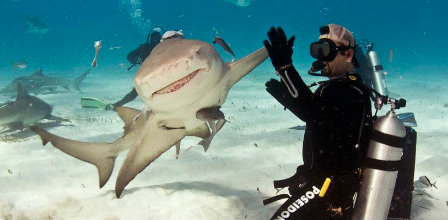- Sections :
- Crime & Public Safety
- Restaurants & Food
- Sports
- More
Categories
Local shark diver, photographer gives insight into sharks

THE WOODLANDS, Texas -- In what has become a cult phenomenon, the Discovery Channel concludes its celebration of the 25th Anniversary of Shark Week with a series of programs answering everything you’ve ever wanted to know about the oceans’ greatest predator. Or did it?
Woodlands resident, Paul Spielvogel, real estate attorney and escrow officer for American Title Company, shark diver and acclaimed photographer for "Shark Diver" magazine, provided insight into what we don't know about sharks.
Spielvogel’s magnificent underwater photography has been featured in numerous other publications. One of Spielvogel’s photographs of a diver interacting with a Lemon shark recently went viral over the Internet, appeared on Inside Edition and was published in numerous world-wide publications with over forty million views to date.
Receiving his diver certification at the earliest possible age of 16, Spielvogel was mesmerized by the television series, “Sea Hunt” starring Lloyd Bridges, and the undersea exploits of the legendary Jacques Cousteau. Originally fascinated with the undersea world in its entirety, Spielvogel’s fascination with sharks has become his passion and his dives are now shark specific.
Paradoxically, he revealed that the world’s greatest predator wasn’t sharks, but man. An estimated 73 million sharks are mutilated annually for shark fin soup, considered a delicacy in Asian restaurants worldwide. DNA evidence collected from soup samples in U.S. restaurants conclusively revealed that the Tiger shark, Bull shark, and two different species of Hammerhead shark, have been caught and mutilated for their fins.
“Conversely, humans are not the diet of sharks," Spielvogel said. "Their senses are so sharp they know the difference between their normal diet and human flesh. Sharks are scavengers. They keep the ocean clean and are a vital part of the ocean’s eco-system. Depletion of sharks will radically affect oceanic balance.”
To reverse the trend of catching and mutilating sharks for their fins, a world-wide conservation movement is aimed at educating the public. One of Spielvogel’s shark photographs was selected by "Ocean Geographic" as the poster child for this campaign and has been used on billboards throughout China for the cause.
Spielvogel said knowing the personality traits of shark species makes their annihilation even more disturbing.
“Hammerhead sharks are very shy, and avoid people,” Spielvogel said. “Whale sharks are gentle giants. Tiger and Lemon sharks are very engaging and can even be playful. They’ve become ‘peoplelized’ because of the diver interaction in specific regions.” And what about the Great White shark? “That’s a different species in and of itself commanding the most respect. It’s the consummate predator. It’s the ‘top-of-the-food-chain’ hunter, said Spielvogel.
Asked if he used cages and chain mail when diving with sharks, Spielvogel said the diver handling bait will often wear chain mail, and it’s imperative to use cages when diving with the Great White sharks. Although there was one occasion when he didn’t, and he found himself with three Great Whites in open water without incident. The purpose of the dive was to photo-document the retrieval of a data receiver used to store information of tagged Great Whites at Isla Guadalupe in Mexico. Spielvogel unexpectedly found himself confronted with an 18-foot Great White named “Shredder”. Spielvogel was later informed that there were actually three sharks in the water, but he only saw the one.
“You draw on your experience working with sharks,” said Spielvogel. “The more you dive with them, the more you know how to read them, and that requires ‘time in the water’ and confidence.”
Spectacular shark photography doesn’t come easily. Spielvogel said it takes countless hours and often numerous dives just to get a good shot, but it’s what keeps him at it. Spielvogel said it’s the purpose of shark divers to debunk the Hollywood “Jaws” portrayal of sharks, the Great White in particular.
“The more we interact with sharks to collect photos and data about their behavior, the more science will gain a better understanding of them,” said Spielvogel.
. Upcoming dives include a local one the weekend of August 18. Spielvogel will be diving with the local sharks in Houston’s Downtown Aquarium. One of only two outsiders allowed in the tank, the other is the editor of "Shark Diver Magazine," Eli Martinez.
“The opportunity to dive with the sharks in the Houston Aquarium not only satisfies my urge to shark dive until I can go on another excursion, but also, allows me to capture images of shark species that I may not get the opportunity to photograph,” Spielvogel said.
Spielvogel is currently scheduled for another shark dive in August to dive with Blue and Mako sharks. The dive will include his daughter, Jessie Spielvogel, President of Split Aces Media, who previously worked as a social media specialist with the Discovery Channel. Thereafter, Spielvogel heads back to Isla Guadalupe to capture more images of the Great White.
To learn more about sharks visit Shark Diver Magazine. To obtain a Shark Survival Guide go to Discovery Channel – Shark Week
Photo caption: Shark Diver Magazine editor, Eli Martinez, getting a ‘high five’ from a Lemon shark, photographed by Paul Spielvogel. The photo is the iconic viral photograph referenced in the article, and the current cover photo of "Shark Diver Magazine," Issue 25.
Discovery Channel 25th Anniversary of Shark Week highlighted by shark diver.
Woodlands resident, Paul Spielvogel, real estate attorney and escrow officer for American Title Company, shark diver and acclaimed photographer for "Shark Diver" magazine, provided insight into what we don't know about sharks.
Spielvogel’s magnificent underwater photography has been featured in numerous other publications. One of Spielvogel’s photographs of a diver interacting with a Lemon shark recently went viral over the Internet, appeared on Inside Edition and was published in numerous world-wide publications with over forty million views to date.
Receiving his diver certification at the earliest possible age of 16, Spielvogel was mesmerized by the television series, “Sea Hunt” starring Lloyd Bridges, and the undersea exploits of the legendary Jacques Cousteau. Originally fascinated with the undersea world in its entirety, Spielvogel’s fascination with sharks has become his passion and his dives are now shark specific.
Paradoxically, he revealed that the world’s greatest predator wasn’t sharks, but man. An estimated 73 million sharks are mutilated annually for shark fin soup, considered a delicacy in Asian restaurants worldwide. DNA evidence collected from soup samples in U.S. restaurants conclusively revealed that the Tiger shark, Bull shark, and two different species of Hammerhead shark, have been caught and mutilated for their fins.
“Conversely, humans are not the diet of sharks," Spielvogel said. "Their senses are so sharp they know the difference between their normal diet and human flesh. Sharks are scavengers. They keep the ocean clean and are a vital part of the ocean’s eco-system. Depletion of sharks will radically affect oceanic balance.”
To reverse the trend of catching and mutilating sharks for their fins, a world-wide conservation movement is aimed at educating the public. One of Spielvogel’s shark photographs was selected by "Ocean Geographic" as the poster child for this campaign and has been used on billboards throughout China for the cause.
Spielvogel said knowing the personality traits of shark species makes their annihilation even more disturbing.
“Hammerhead sharks are very shy, and avoid people,” Spielvogel said. “Whale sharks are gentle giants. Tiger and Lemon sharks are very engaging and can even be playful. They’ve become ‘peoplelized’ because of the diver interaction in specific regions.” And what about the Great White shark? “That’s a different species in and of itself commanding the most respect. It’s the consummate predator. It’s the ‘top-of-the-food-chain’ hunter, said Spielvogel.
Asked if he used cages and chain mail when diving with sharks, Spielvogel said the diver handling bait will often wear chain mail, and it’s imperative to use cages when diving with the Great White sharks. Although there was one occasion when he didn’t, and he found himself with three Great Whites in open water without incident. The purpose of the dive was to photo-document the retrieval of a data receiver used to store information of tagged Great Whites at Isla Guadalupe in Mexico. Spielvogel unexpectedly found himself confronted with an 18-foot Great White named “Shredder”. Spielvogel was later informed that there were actually three sharks in the water, but he only saw the one.
“You draw on your experience working with sharks,” said Spielvogel. “The more you dive with them, the more you know how to read them, and that requires ‘time in the water’ and confidence.”
Spectacular shark photography doesn’t come easily. Spielvogel said it takes countless hours and often numerous dives just to get a good shot, but it’s what keeps him at it. Spielvogel said it’s the purpose of shark divers to debunk the Hollywood “Jaws” portrayal of sharks, the Great White in particular.
“The more we interact with sharks to collect photos and data about their behavior, the more science will gain a better understanding of them,” said Spielvogel.
. Upcoming dives include a local one the weekend of August 18. Spielvogel will be diving with the local sharks in Houston’s Downtown Aquarium. One of only two outsiders allowed in the tank, the other is the editor of "Shark Diver Magazine," Eli Martinez.
“The opportunity to dive with the sharks in the Houston Aquarium not only satisfies my urge to shark dive until I can go on another excursion, but also, allows me to capture images of shark species that I may not get the opportunity to photograph,” Spielvogel said.
Spielvogel is currently scheduled for another shark dive in August to dive with Blue and Mako sharks. The dive will include his daughter, Jessie Spielvogel, President of Split Aces Media, who previously worked as a social media specialist with the Discovery Channel. Thereafter, Spielvogel heads back to Isla Guadalupe to capture more images of the Great White.
To learn more about sharks visit Shark Diver Magazine. To obtain a Shark Survival Guide go to Discovery Channel – Shark Week
Photo caption: Shark Diver Magazine editor, Eli Martinez, getting a ‘high five’ from a Lemon shark, photographed by Paul Spielvogel. The photo is the iconic viral photograph referenced in the article, and the current cover photo of "Shark Diver Magazine," Issue 25.
Comments •

















